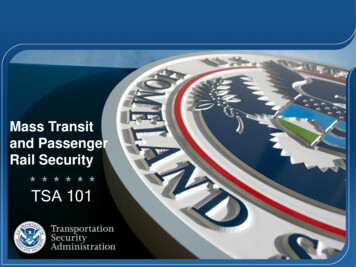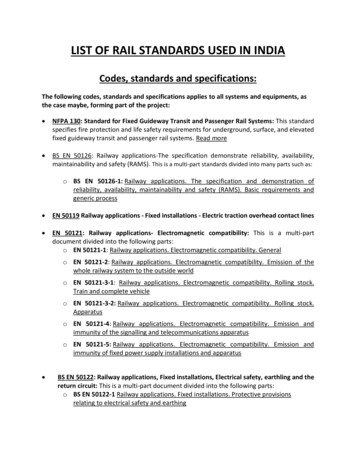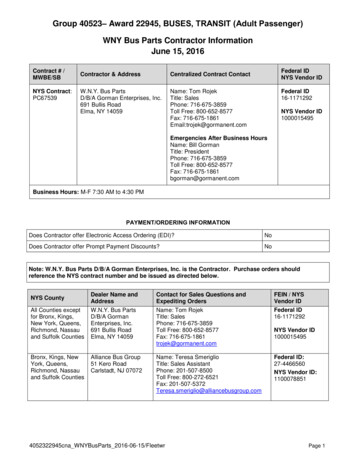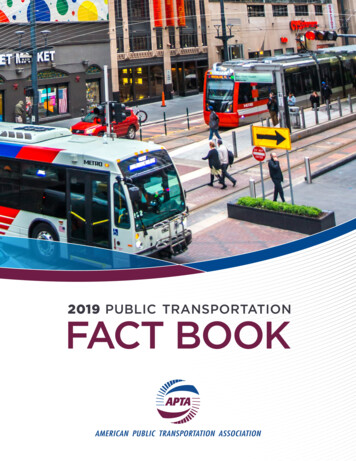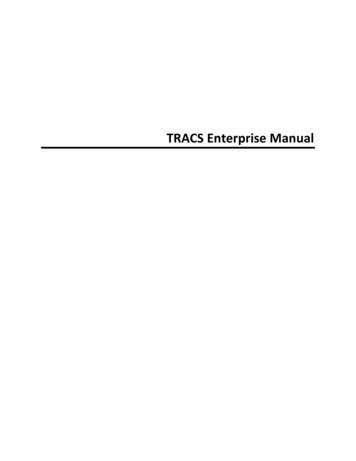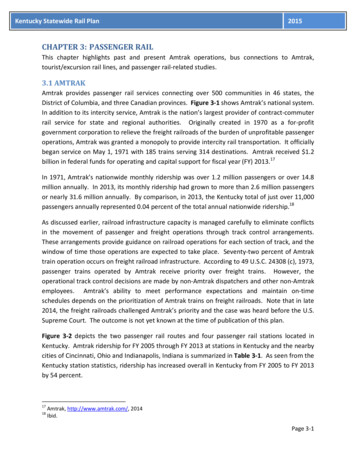
Transcription
Kentucky Statewide Rail Plan2015CHAPTER 3: PASSENGER RAILThis chapter highlights past and present Amtrak operations, bus connections to Amtrak,tourist/excursion rail lines, and passenger rail‐related studies.3.1 AMTRAKAmtrak provides passenger rail services connecting over 500 communities in 46 states, theDistrict of Columbia, and three Canadian provinces. Figure 3‐1 shows Amtrak’s national system.In addition to its intercity service, Amtrak is the nation’s largest provider of contract‐commuterrail service for state and regional authorities. Originally created in 1970 as a for‐profitgovernment corporation to relieve the freight railroads of the burden of unprofitable passengeroperations, Amtrak was granted a monopoly to provide intercity rail transportation. It officiallybegan service on May 1, 1971 with 185 trains serving 314 destinations. Amtrak received 1.2billion in federal funds for operating and capital support for fiscal year (FY) 2013.17In 1971, Amtrak’s nationwide monthly ridership was over 1.2 million passengers or over 14.8million annually. In 2013, its monthly ridership had grown to more than 2.6 million passengersor nearly 31.6 million annually. By comparison, in 2013, the Kentucky total of just over 11,000passengers annually represented 0.04 percent of the total annual nationwide ridership.18As discussed earlier, railroad infrastructure capacity is managed carefully to eliminate conflictsin the movement of passenger and freight operations through track control arrangements.These arrangements provide guidance on railroad operations for each section of track, and thewindow of time those operations are expected to take place. Seventy‐two percent of Amtraktrain operation occurs on freight railroad infrastructure. According to 49 U.S.C. 24308 (c), 1973,passenger trains operated by Amtrak receive priority over freight trains. However, theoperational track control decisions are made by non‐Amtrak dispatchers and other non‐Amtrakemployees. Amtrak’s ability to meet performance expectations and maintain on‐timeschedules depends on the prioritization of Amtrak trains on freight railroads. Note that in late2014, the freight railroads challenged Amtrak’s priority and the case was heard before the U.S.Supreme Court. The outcome is not yet known at the time of publication of this plan.Figure 3‐2 depicts the two passenger rail routes and four passenger rail stations located inKentucky. Amtrak ridership for FY 2005 through FY 2013 at stations in Kentucky and the nearbycities of Cincinnati, Ohio and Indianapolis, Indiana is summarized in Table 3‐1. As seen from theKentucky station statistics, ridership has increased overall in Kentucky from FY 2005 to FY 2013by 54 percent.1718Amtrak, http://www.amtrak.com/, 2014Ibid.Page 3‐1
Kentucky Statewide Rail Plan2015Figure 3‐1: Amtrak National SystemSource: http://www.amtrak.com/ccurl/948/674/System0211 101web,0.pdf, 2014Page 3‐2
Kentucky Statewide Rail Plan2015Figure 3‐2: Passenger Rail Lines in KentuckySource: KYTC, 2014Page 3‐3
Kentucky Statewide Rail Plan2015Table 3‐1: Amtrak Annual Total Ridership for Selected Years and CitiesCityKentucky dFultonMaysvilleS. PortsmouthKentucky TotalRegional 074,5882,4111,01011,016Cincinnati, OHIndianapolis, 415,213*35,300Regional 56050,513* Denotes that ridership data is from U.S. House of Representatives KY District 4 Fact Sheet, 2010‐2013Source: www.amtrak.com – About Amtrak – Facts & Services – State Fact Sheets, 2005‐20133.1.1 Amtrak Routes in KentuckyAmtrak trains stop at four stations in Kentucky. The Cardinal stops in the Kentucky cities ofMaysville, South Portsmouth, and Ashland. The Cardinal runs three trains per week betweenChicago, Illinois and Washington, D.C., offering both sleeper and diner cars. The City of NewOrleans provides service between Chicago and New Orleans, Louisiana, with a stop in Kentuckyin the city of Fulton. The City of New Orleans offers daily service with sleeper and diner cars.Between 1999 and 2003, Amtrak operated the former Kentucky Cardinal, which connectedLouisville and Chicago, through Jeffersonville and Indianapolis, Indiana. The service wasdiscontinued in 2003, due to delays crossing the Ohio River, low track speeds, and lowridership. Riders in Louisville may now take a connecting bus to Indianapolis to meet theCardinal.3.1.2 Bus Services Connecting Passengers to Amtrak RoutesThruway Motorcoach Service, operated by Greyhound, provides bus connections from Amtrakstations to other communities not currently served by Amtrak. Guaranteed connections to anAmtrak train station, through‐fares, and common ticketing are provided in most cases. AThruway bus connection is provided at Louisville, connecting Louisville and Indianapolis,Indiana, and continuing on to Chicago, Illinois. The Thruway connection out of Cincinnatiprovides a link to Columbus, Ohio and Pittsburgh, Pennsylvania. Bus connections are alsoavailable to Amtrak passengers at Ashland and Fulton.Page 3‐4
Kentucky Statewide Rail Plan20153.2 TOURIST/EXCURSION RAIL LINESFive tourist/excursion trains operate in Kentucky, as described below with locations noted inFigure 3‐2.3.2.1 Big South Fork Scenic RailwayLocated in Stearns, the Big South Fork Scenic Railway is an excursion railroad that takespassengers on a 14‐mile roundtrip tour to the National Park Service’s Blue Heron Coal MiningCamp representation within the Big South Fork National River Recreation Area. It operates on aline that is owned by the McCreary County Heritage Foundation in McCreary County andfeatures tunnels, walking paths, an abandoned mine, a snack bar, and a gift shop. The train is inoperation from April through December.19 The line operates over one mile of Kentucky andTennessee Railroad’s yard track to connect its station to its rail line.3.2.2 Bluegrass Scenic Railroad and MuseumLocated near downtown Versailles, the Bluegrass Scenic Railroad and Museum offers an 11‐mile/90‐minute roundtrip tour within the Bluegrass Region of Kentucky, from Versailles towardthe Kentucky River, along the only railroad line in Kentucky not used to transport freight. Thistour uses the former mainline of the now defunct Louisville Southern Railroad. In addition tothe tour, the museum exhibits include a display car.203.2.3 Kentucky Railway MuseumLocated in New Haven, the Kentucky Railway Museum operates over 22 roundtrip miles of trackthat were formerly part of the Lebanon Branch of the Louisville & Nashville Railroad (a CSXTpredecessor) through Nelson and LaRue counties. The main depot is located in New Havenwith a passenger boarding area in Boston. In addition to a scenic tour, the museum offers acollection of artifacts such as locomotives and cars, train memorabilia, and a gift shop.213.2.4 My Old Kentucky Dinner TrainLocated in Bardstown, My Old Kentucky Dinner Train began operation in 1988. Originallyconstructed by the Bardstown and Louisville Railroad in 1860, the branch was purchased fromCSXT in 1987 by the R.J. Corman Railroad Group. The train travels through Bernheim Forest,and the Jim Beam distillery property, to Limestone Springs and back to Bardstown. The trip is a37‐mile roundtrip excursion taking approximately two and a half hours. My Old KentuckyDinner Train offers special children's excursions for ages three through 12 and breakfastexcursions that are each approximately one and a half hours. My Old Kentucky Dinner Trainprimarily runs on the R.J. Corman Railroad Group’s Bardstown Line in Nelson County.2219Big South Fork Scenic Railway, http://bsfsry.com/, 2014Bluegrass Scenic Railroad and Museum, http://www.bgrm.org/, 201421Kentucky Railway Museum, http://www.kyrail.org/, 201422My Old Kentucky Dinner Train and R.J. Corman’s Lexington Dinner Train, http://www.kydinnertrain.com/, 201420Page 3‐5
Kentucky Statewide Rail Plan20153.2.5 R.J. Corman Lexington Dinner TrainThe R.J. Corman Railroad Group’s Lexington Dinner Train, which began in 2013, travelsapproximately 30 miles roundtrip from R.J. Corman’s Lexington Station past the KeenelandRace Course, the Village of Pisgah, to the city of Versailles. The train ride is approximately twohours for lunch trips and two and a half hours for dinner excursions. Children's excursions forages three through 12 and breakfast excursions are each approximately one and a half hours.The R.J. Corman Lexington Dinner Train runs on the R.J. Corman Railroad Group’s CentralKentucky Line in Fayette and Woodford counties.233.3 STUDIES REGARDING PASSENGER RAIL IN KENTUCKYSeveral studies exploring the potential expansion and feasibility of passenger rail in Kentuckyhave been completed by various entities. The most relevant studies are described below.3.3.1 Ohio‐Kentucky‐Indiana Light Rail Project (1998‐2001) 24In March 1998, the Ohio‐Kentucky‐Indiana Regional Council of Governments (OKI), the MPO ofthe Cincinnati ‐ Northern Kentucky urbanized area, completed the I‐71 Major Investment Study(MIS). The MIS included the selection of a locally preferred alternative that recommended thedesign and construction of a 43‐mile light rail transit (LRT) line. LRT is an electrified trainsystem that can run at street level in mixed traffic or on its own exclusive track and is poweredby overhead electric lines.The 43‐mile LRT line included a 19‐mile minimum operating segment (MOS‐1) from 12th Streetin Covington, Kentucky north to downtown Cincinnati, and terminated in Blue Ash, Ohio. TheMOS‐1 included 24 proposed stations. In accordance with federal regulations regarding themetropolitan planning process, the project was included in the OKI Long RangeTransportation Plan (LRTP) and Transportation Improvement Program (TIP). Using 5.8million in Federal Transit Administration (FTA) Section 5307 flexible funds, the SouthwestOhio Regional Transit Authority (SORTA) purchased several portions of active and abandonedrailroad right of way for the proposed LRT project.In December 1998, FTA approved the initiation of preliminary engineering and thepreparation of a Draft Environmental Impact Statement (DEIS) for MOS‐1. The DEIS wascompleted in 2001.25 Section 3030(b) (66) of the federal transportation bill, TransportationEquity Act for the 21st Century (TEA‐21), authorized the Cincinnati/Northern KentuckyNortheast Corridor for final design and construction. Through FY 2001, the U.S. Congress hadappropriated 9.75 million in FTA Section 5309 New Starts funds for the proposed project.23Ibíd.http://www.fta.dot.gov/printer friendly/12304 2923.html, 201425Ohio‐Kentucky‐Indiana Regional Council of Governments, deis/,201424Page 3‐6
Kentucky Statewide Rail Plan2015However, the FTA gave the project an overall rating of Not Recommended based on theproject’s poor cost‐effectiveness, absence of transit‐supportive land use policies in thecorridor, and the lack of local financial commitment to build and operate the proposed LRTsystem. With no other source for ongoing funding, the project was abandoned.263.3.2 Louisville Transportation Tomorrow Light Rail Project (1998‐2006)27The Transit Authority of River City (TARC), Louisville, Kentucky’s urban transit service provider,examined the feasibility of LRT in the Louisville and southern Indiana region through thedevelopment of the Transportation Tomorrow (T2)MIS.Figure 3‐3: TARC T2 Proposed LightRail RouteThree subsequent phases of T2 examined thesystem’s benefits or sought to develop designdocuments and provide environmental reports.Phase I took place from 1994 to 1996 with the MISconcluding that a LRT system in Louisville wasgenerally feasible. Phase II from 1997 to 1998examined the benefits that a LRT system would bringto Louisville. These benefits included improvedmobility, development and redevelopment of certainneighborhoods, reduced air pollution, and the easingof congestion on I‐65. Alternatives to a LRT systemincluded doing nothing, enhancing bus service,improving roadways, and adding bus‐ways and highoccupancy vehicle lanes.Phase III took place from 1998 to 2000. It reaffirmedLRT as the preferred mode and chose a general routefor the system. The study concluded with a proposedroute as shown in Figure 3‐3, preliminary costestimates for capital and operating expenses,planning level design, and estimated ridership. T2was entered into the FTA’s New Starts Program. Inaccordance with federal regulations regarding themetropolitan planning process, the project wasincluded in the Kentuckiana Regional Planning bout TARC/Long Range Plan/Long%20Range%20Plan.pdf, 201426Federal Transit Administration, http://www.fta.dot.gov/12304 3149.html, ansit‐trip‐portland‐ore/,201427Page 3‐7
Kentucky Statewide Rail Plan2015Development Agency’s (KIPDA’s) Long Range Transportation Plan (LRTP) and TransportationImprovement Program (TIP). The project then progressed into the preliminary engineeringphase after both the FTA issued a Recommended rating for New Starts and the DEIS wascompleted, but not released for public review. From 2004 to 2006, the FTA indicated that theproject’s movement into the final design phase was not possible without a secured localfunding match. According to TARC, the project was withdrawn from the New Starts Programdue to the inability to secure local funding.283.3.3 Examination of I‐75, I‐64, and I‐71 High Speed Rail Corridors (1999)29A review of high‐speed rail services, proposals, and a preliminary assessment of the potentialfor high‐speed rail transportation between three Kentucky cities: Lexington, Louisville, andCovington, was performed for the KYTC in 1999. Connections to Frankfort, Kentucky andCincinnati, Ohio, were also evaluated in the study.Annual ridership was estimated to be 94,000 passengers, which included rail passengersconnecting to airline service at the Cincinnati/Northern Kentucky International Airport inCovington and a Cincinnati connection with the Midwest Regional Rail Initiative (MWRRI).Capital costs were estimated to be 5.48 billion, with annual operations and maintenance costsof approximately 40 million. Annual revenues were expected to range from 5.5 to 7.7million based on a fare of 34.50 to and from the cities of Cincinnati, Lexington, and Louisville.The fare for the Frankfort to Lexington trip was priced at 6.50.It was concluded that the proposed service faced a number of challenges, of which the mostsignificant was that fares would only return 15 percent of the operating costs – meaning that inorder to cover these costs, the fares would have to be raised to 190 per leg or 245 for aroundtrip. In addition, it was determined that adjacent and parallel highways would offerfaster travel times and speeds, making it difficult to attract sufficient ridership to supportoperating costs.3.3.4 Midwest Regional Rail Initiative Executive Report (2004)30The Midwest Regional Rail Initiative (MWRRI) was formed in 1996 by several statesincluding Illinois, Indiana, Kansas, Michigan, Minnesota, Missouri, Nebraska,North Dakota, and Wisconsin, in an effort to improve and expand passenger rail servicein the Midwest. Its objectives are to increase operating speeds, train frequencies, systemconnectivity over the existing network, and service reliability. The consortium has alsodeveloped the proposed Midwest Regional Rail System (MWRRS) to improve the level and28Transit Authority of River City, http://www.ridetarc.org/faq/#Light Rail, �71%20High%20Speed%20Rail.PDF, ��MWRRSServiceDevelopmentPlan Exec 330322 7.pdf, 201429Page 3‐8
Kentucky Statewide Rail Plan2015quality of existing regional passenger rail service, and thereby improving mobility as well asstimulating economic development.Various studies have been produced by MWRRI in 1998, 2000, 2004, and most recently in2007.31 Participants included the states of Indiana, Illinois, Michigan, Minnesota, Missouri,Nebraska, North Dakota, and Wisconsin. Amtrak and the FRA also participated. Kentucky isnot currently participating in the MWRRI because no funding is presently available tosupport MWRRS development. The KYTC has reserved the right to reconsider its position iffunding were to become available. Connections to Kentucky are proposed by bus.The proposed MWRRS network is comprised of nine corridors consisting of 3,000 routemiles, as shown in Figure 3‐4. The majority of the system is owned by freight railroads withthe remainder owned by Amtrak and Metra (Chicago, Illinois’ commuter rail operator).The proposed passenger rail system would have a station located in Cincinnati, Ohio, withfeeder bus service connecting to the Kentucky cities of Lexington, Paducah, and in Illinois, thecity of Carbondale.The initial implementation of the proposed MWRRS service was part of a 10‐year phasedprogram, as called for in the 2004 MWRRI Executive idwest1.pdf, port.pdf, 2014Page 3‐9
Kentucky Statewide Rail Plan2015Figure 3‐4: Proposed MWRRS System MapSource: ioverallmap.pdf, 2014According to the MWRRI Executive Report, the capital costs of MWRRS include twocomponents: rolling stock and infrastructure. Total capital investments are projected to be 7.7 billion, with rolling stock costs expected to be approximately 1.1 billion and infrastructurecosts estimated at 6.6 billion. Infrastructure costs include the implementation of a positivetrain control (PTC) signaling system, improvement of highway‐rail at‐grade crossings, andconstruction or renovation of passenger stations.3.3.5 Atlanta to Chattanooga to Nashville to Louisville High Speed Rail Study (2012)33This study was undertaken by the Georgia Department of Transportation (GDOT) to evaluatethe need for, and effectiveness of, several potential rail corridors connecting Atlanta, Georgiawith other cities in the region. Three corridors were a/rail/Documents/HighSpeedRail/Final%20Report.pdf, 2014Page 3‐10
Kentucky Statewide Rail Plan ville; and,Atlanta‐Chattanooga‐Nashville‐Louisville (Atlanta‐Louisville corridor).The feasibility of both Emerging High‐Speed Rail (90‐110 mph) service and Express High‐SpeedRail (180‐220 mph) service, as designated by the FRA, was examined in each corridor. Theformer can be operated on track shared with freight railroads, while the latter requiresdedicated track and right of way.In addition, a maglev alternative (more than 220 mph) was evaluated in the Atlanta‐Louisvillecorridor. Maglev, a term derived from magnetic levitation, is a method of propulsion that usesmagnetic levitation to propel trains with magnets rather than with wheels, axles, and bearings.With maglev, a train or car is levitated a short distance above a guideway, using magnets tocreate both lift and thrust. High‐speed maglev trains promise dramatic improvements fortravel.34A representative route was identified for each corridor and service type. These were notintended to be the preferred or recommended alternatives, but served as representativeexamples to evaluate high‐speed rail performance in the corridors. Each route could haveseveral alignments which would be analyzed in more detail as part of the federally requiredenvironmental review, if the route is selected for future analysis.With respect to Kentucky, the Atlanta‐Louisville corridor would extend from Hartsfield‐JacksonAtlanta International Airport to downtown Louisville, as shown in Figure ransport‐explained/, 2014Page 3‐11
Kentucky Statewide Rail Plan2015Figure 3‐5: Proposed High Speed Rail Route from Atlanta to LouisvilleSource: Atlanta to Chattanooga to Nashville to Louisville High Speed Rail Study, Georgia Department ofTransportation (GDOT), 2012The Emerging High‐Speed Rail service, a shared use route, is proposed to follow a CSXT line.The Express High‐Speed Rail Route, a dedicated use route would follow I‐75 from Atlanta,Georgia to Chattanooga, Tennessee; I‐24 from Chattanooga to Nashville, Tennessee; and I‐65Page 3‐12
Kentucky Statewide Rail Plan2015from Nashville to Louisville, Kentucky. With the exception of Marietta, Georgia, which wouldonly have a station under the Emerging High Speed Rail scenario, both scenarios would havestations at these locations: Hartsfield‐Jackson AtlantaInternational Airport, Atlanta,Georgia;Atlanta Multi‐Modal PassengerTerminal, Atlanta, Georgia;Cumberland/Galleria, Georgia;Marietta, Georgia;Cartersville, Georgia;Dalton, Georgia;Lovell Airport Field, Tennessee; Downtown Chattanooga, Tennessee;Murfreesboro, Tennessee;Nashville International Airport,Tennessee;Downtown Nashville, Tennessee;Bowling Green, Kentucky;Elizabethtown, Kentucky;Louisville International Airport,Kentucky; and,Downtown Louisville, Kentucky.The analysis showed that the trip time between Atlanta and Louisville in the shared usescenario would be approximately 6 hours and 55 minutes with an average speed of 72 mph.Comparatively, the trip would take approximately the same time as driving along the nearestinterstate highway.35 Conventional high speed trains operating on a passenger‐only trackwould average 122 mph for an approximate trip time of 3 hours and 32 minutes between thetwo cities, substantially faster than driving. Finally, the maglev service would operate at anaverage speed of 143 mph, completing the trip in approximately 3 hours and 2 minutes.Estimated capital costs, operations and maintenance costs, as well as ridership and revenue,are depicted in Table 3‐2 for the years 2021 to 2040.Table 3‐2: Estimated Costs & Operational Statistics for Atlanta to Louisville High Speed RailScenarios, 2021‐2040Emerging High SpeedExpress High SpeedMaglevRidership101.9 million110.6 million116.1 millionCapital Costs 11.5 billion 32.6 billion 43 billionO&M Costs 2.8 billion 5.8 billion 4.5 billionRevenue 4.2 billion 6.4 billion 6.8 billionAvg. Fare 41.22 57.87 58.57Source: Atlanta to Chattanooga to Nashville to Louisville High Speed Rail Study, Georgia Department ofTransportation (GDOT), l/Documents/HighSpeedRail/Final%20Report.pdf, 2014Page 3‐13
Kentucky Statewide Rail Plan2015The Emerging High‐Speed Rail, Express High‐Speed Rail, and maglev alternatives performed wellunder the operating ratio analysis, resulting in anticipated ridership versus estimated revenueratios well above the necessary benefit‐cost ratio for all three scenarios. When revenuesexceed operating costs, operating subsidies are not required. The excess funds could bereinvested in the rail service or used to pay existing debt. The operating revenue surplus couldencourage investment form the private sector, reducing public financing required.Taking into account the operating ratios and benefit‐cost ratios, the study recommended thatthe results be used to set priorities for future state planning and corridor developmentactivities. In particular, this study found that high‐speed passenger rail service is feasible in theAtlanta‐Chattanooga‐Nashville‐Louisville Corridor.36The study concluded that high‐speed rail service in the idor presents an opportunity to provide needed transportation solutions and promoteeconomic development. While high‐speed rail is not the only transportation solution, this studyshowed that high‐speed passenger rail would give consumers improved mobility andtransportation mode choices, with connectivity to major cities such as Atlanta, Chattanooga,Nashville, and Louisville through commercial centers and national destinations.36Ibid.Page 3‐14
Kentucky Statewide Rail Plan 2015 CHAPTER 3: PASSENGER RAIL . and the Jim Beam distillery property, to Limestone Springs and back to Bardstown. The trip is a 37‐mile roundtrip
